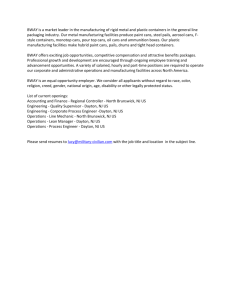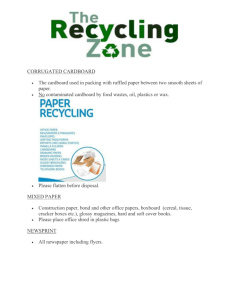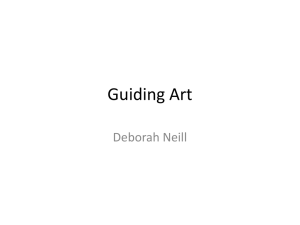Art - Region 9 ESC
advertisement
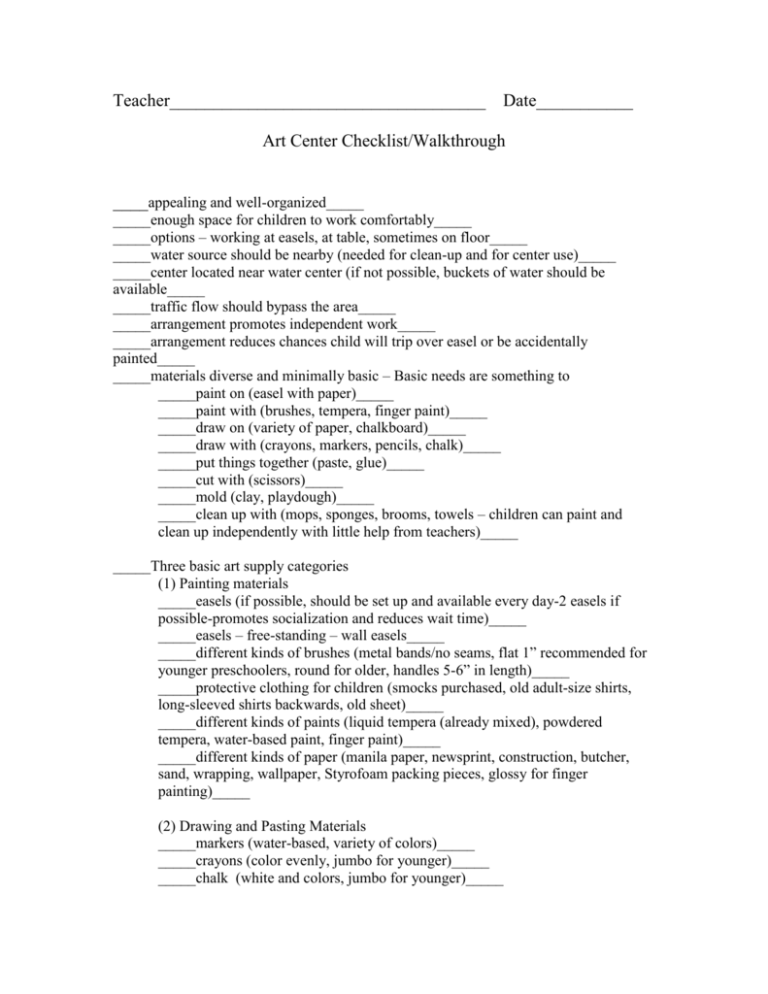
Teacher____________________________________ Date___________ Art Center Checklist/Walkthrough ____appealing and well-organized_____ _____enough space for children to work comfortably_____ _____options – working at easels, at table, sometimes on floor_____ _____water source should be nearby (needed for clean-up and for center use)_____ _____center located near water center (if not possible, buckets of water should be available_____ _____traffic flow should bypass the area_____ _____arrangement promotes independent work_____ _____arrangement reduces chances child will trip over easel or be accidentally painted_____ _____materials diverse and minimally basic – Basic needs are something to _____paint on (easel with paper)_____ _____paint with (brushes, tempera, finger paint)_____ _____draw on (variety of paper, chalkboard)_____ _____draw with (crayons, markers, pencils, chalk)_____ _____put things together (paste, glue)_____ _____cut with (scissors)_____ _____mold (clay, playdough)_____ _____clean up with (mops, sponges, brooms, towels – children can paint and clean up independently with little help from teachers)_____ _____Three basic art supply categories (1) Painting materials _____easels (if possible, should be set up and available every day-2 easels if possible-promotes socialization and reduces wait time)_____ _____easels – free-standing – wall easels_____ _____different kinds of brushes (metal bands/no seams, flat 1” recommended for younger preschoolers, round for older, handles 5-6” in length)_____ _____protective clothing for children (smocks purchased, old adult-size shirts, long-sleeved shirts backwards, old sheet)_____ _____different kinds of paints (liquid tempera (already mixed), powdered tempera, water-based paint, finger paint)_____ _____different kinds of paper (manila paper, newsprint, construction, butcher, sand, wrapping, wallpaper, Styrofoam packing pieces, glossy for finger painting)_____ (2) Drawing and Pasting Materials _____markers (water-based, variety of colors)_____ _____crayons (color evenly, jumbo for younger)_____ _____chalk (white and colors, jumbo for younger)_____ _____chalkboards (black, white, or green, wall-mounted - easel-like-lap)_____ _____scissors (both left and right-handed, safety for beginners)_____ _____paper (variety of colors, sizes, textures)_____ _____white glue (water-based and school paste, do NOT use instant-epoxysolvent bond –toxic)_____ (3) Sculpting and Molding Materials _____playdough (vary texture and colors)_____ _____clay (modeling clay [soft] – use with rolling pins, plastic knives, tongue depressors)_____ _____clay (baking clay [hardens] )_____ Supplemental Art Materials – the listing below offers additional suggestions: Displaying and Storing Materials _____shelves orderly (egg cartons or empty coffee cans for scissors/pencils)_____ _____ice cream containers/newspaper cylinders (good paper holders, collage materials)_____ _____paint caddies (six-pack cardboard beverage containers filled with clean juice cans in each slot)_____ _____clay in airtight containers (plastic or metal with plastic liner, margarine containers, coffee cans, gallon mayonnaise or mustard containers)_____ _____glue/paste (baby-food jars, enough jars on the shelf so each child can have his or her own supply)_____ _____crayon holders (frozen juice cans with colored paper labels to tell the color of crayons)_____ _____yarn dispenser (cardboard box-holes punched in top )_____ _____supplemental materials (closet or on a high bookshelf until needed)_____ Labeling Materials _____labels on storage and display areas_____ _____pictures should be displayed directly on shelf where items are to be stored_____ _____picture-only labels recommended for young preschoolers_____ Drying and Displaying Children’s Artwork _____take care in handling artwork – says a lot to the child_____ _____clothespins on a line_____ _____high enough to be out of way but low enough for child to see)____ _____use photo to mark their place to hang their work_____ _____clothes-drying rack_____ _____drying rack_____ Questions to consider for assessment: Do children use the art area daily? Are art supplies readily accessible? Do both boys and girls join in art activities? What supplies would encourage more play? Do children tend to choose the same art materials day after day? Do children need help using other art materials? Are children regularly engaged in art activities-drawing, painting, sculpting-on their own? Are the materials overwhelming or too advanced? Are spills commonplace? Do children have enough room for play? Do children clean up on their own? Are shelves and containers sufficiently labeled so children know where items belong?
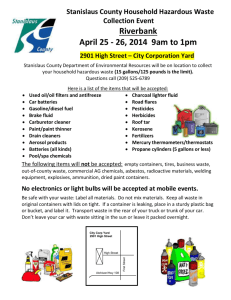

![[Agency] recognizes the hazards of lead](http://s3.studylib.net/store/data/007301017_1-adfa0391c2b089b3fd379ee34c4ce940-300x300.png)
